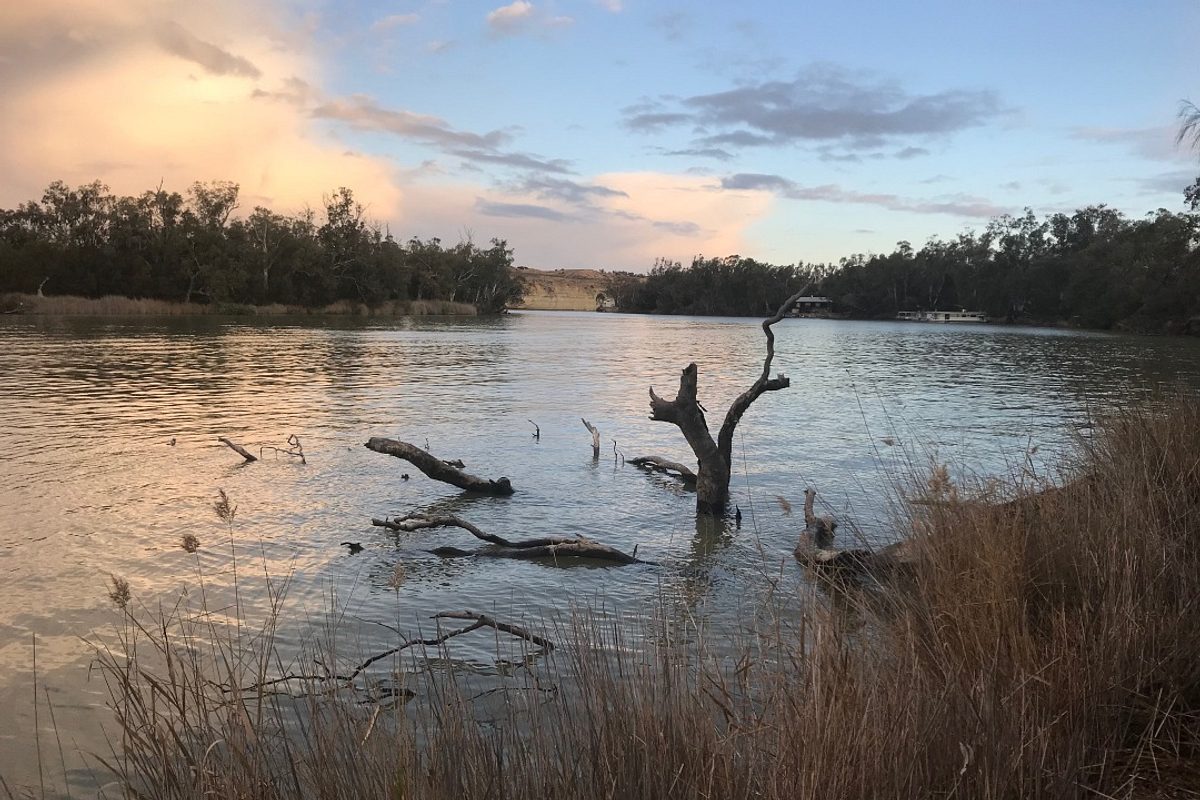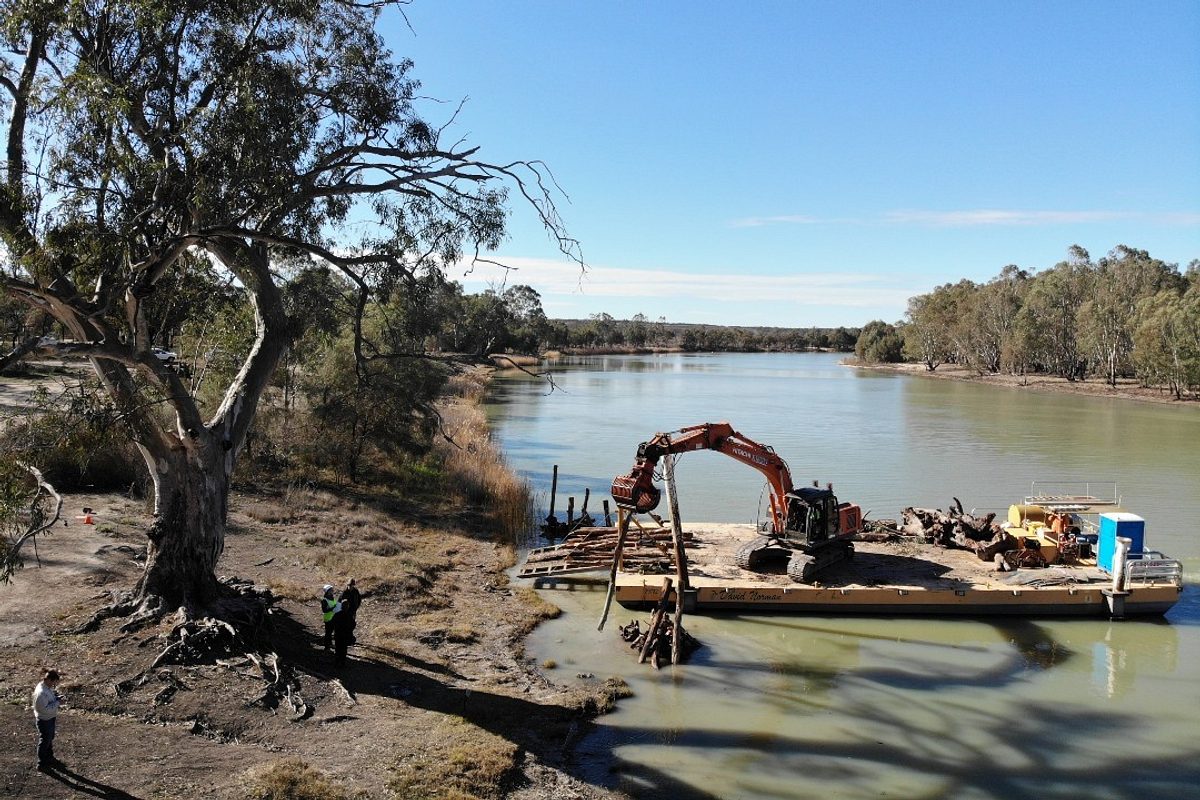Re-snagging: restoring in-stream habitat
Riverland communities are closely connected to the River Murray, relying on it for their economic, social, cultural and recreational wellbeing. Over time, the health of the River Murray has been significantly affected by river regulation, de-snagging (removing trees, branches and root masses), overuse of water resources and drought.
We are undertaking re-snagging to rebuild in-stream woody habitat to restore the ecology of the River Murray and support local fish populations.
What are snags?
Snags are in-stream woody habitat that may be made up of tree root masses, trunks or limbs. Snags naturally form when trees fall into the river following strong winds, floods or drought, and create the in-stream flow variation required by native fish. They also play a critical role in providing a place for bacteria, algae and micro-organisms to grow, as well as habitat for a range of aquatic wildlife, including native fish, macro-invertebrates and crustaceans. Snags are particularly favoured by native fishes, as they provide suitable conditions for breeding, feeding, shelter and rest.

Why we are re-snagging the River Murray
Historically, the South Australian River Murray was de-snagged to aid boat navigation, reduce flood damage and beautify the river. In the 1990s, this practice was abolished as it became clear that snags play an important role in creating riverine habitat.
Habitat degradation due to historical removal of snags is thought to have greatly contributed to declines in native fish populations, which have reduced by more than 90% across Australia since European colonisation. Many Australian species now experience restricted habitats consisting of small and highly fragmented populations, leaving them increasingly vulnerable to extreme environmental events.
Without snags, there is no natural way to replenish native fish populations.
Benefits of re-snagging
- Provide more in-stream woody habitat to support larger populations of aquatic species
- Increase habitat for bacteria, algae, micro-organisms, native fish, invertebrates and crustaceans
- Indirectly support water birds and predatory marsupial populations
- Increase food sources for native fish
- Supports native fish breeding by providing additional surfaces for eggs to be attached to
- Protects native fish populations by providing a place of refuge from larger predators
- Provides a food source for larger predators that like to ‘sit and wait’ for their food
- Supports a larger population of native fish which will be more resilient to changing climate conditions
- Helps sustain native fish populations into the future for recreational fishing

Re-snagging project
So far, the SARFIIP and SRE program's have introduced 53 snags along the River Murray, including:
- 15 snags downstream of Inlet Regulator in Bookmark Creek (2025)
- 6 snags upstream of the previous site at Overland Corner (2025)
- 13 snags downstream of Lock 3 near Overland Corner (2020)
- 10 snags downstream of Lock 4 near Bookpurnong (2020)
- 4 snags at the initial test site downstream of Lock 4 near Bookpurnong (2019)
- 20 snags downstream of Lock 3 near Banrock Station wetland (2019).
How the snag habitats were rebuilt
Rebuilding these in-stream habitats was a complex process requiring the careful selection of tree type, size, shape, position and river location to maximise ecological benefits. Sourcing the right type of wood is essential, as the chosen tree must have been recently felled to ensure the snag will sink, rather than float away. Identifying approved and necessary tree removals is key to re-snagging efforts.
Snag materials for the re-snagging sites were sourced through the Katarapko Floodplain project, with trees removed for construction works being re-introduced into the environment in the form of snags for in-stream habitat.

Banrock station re-snagging site results
In 2019, 20 snags were re-introduced at the site located adjacent to Banrock Station. Recent monitoring has found a range of different native species using new snags in the same way they use natural snags, including:
- silver perch
- unspecked hardyhead
- Murray rainbowfish
- juvenile Murray cod
- bony herring
- Australian smelt.

This project is part of the $37.6 million Sustaining Riverland Environments program, funded by the Australian Government through the Murray-Darling Basin Authority and delivered by the Government of South Australia through the Department for Environment and Water.
More Information
Get involved
We are committed to working with First Nations people, local communities and the broader South Australian community throughout the life of the SRE program.
Subscribe to our email list for updates and SRE engagement opportunities.
Contact us
- Email us at dew.sreprogram@sa.gov.au
- Call the Department for Environment and Water (DEW) on (08) 8204 1910.
Department for Environment and Water (DEW) social media
Resources
SRE project pages
Weir pool manipulation
Other resources
- SA River Murray Flow Report
- Constraints Management Strategy
- Murray-Darling Basin Authority
- Murray-Darling Communities Investment Package
- MDBA Water Recovery Strategy
- South Australian Riverland Floodplains Integrated Infrastructure Program (SARFIIP)
- The Ramsar Convention on Wetlands
The Sustaining Riverland Environments Program is a $37.6 million program funded by the Australian Government through the Murray-Darling Basin Authority and delivered by the Government of South Australia through the Department for Environment and Water.





